A Private Tour today in North Norfolk. A glorious sunny day, unseasonably warm with temperatures up to 16C by the afternoon. With lots of birds singing now, it felt like spring had sprung! But it is not set to last, so we had a good day out trying to make the most of it.
There have been lots of birds on the sea in NW Norfolk in the last few days – divers, grebes, seaduck – so we decided to start the day up there to try to see some of them. On our way west along the coast road, we stopped to admire a Barn Owl which was dozing on a post, warming itself in the early sunshine.
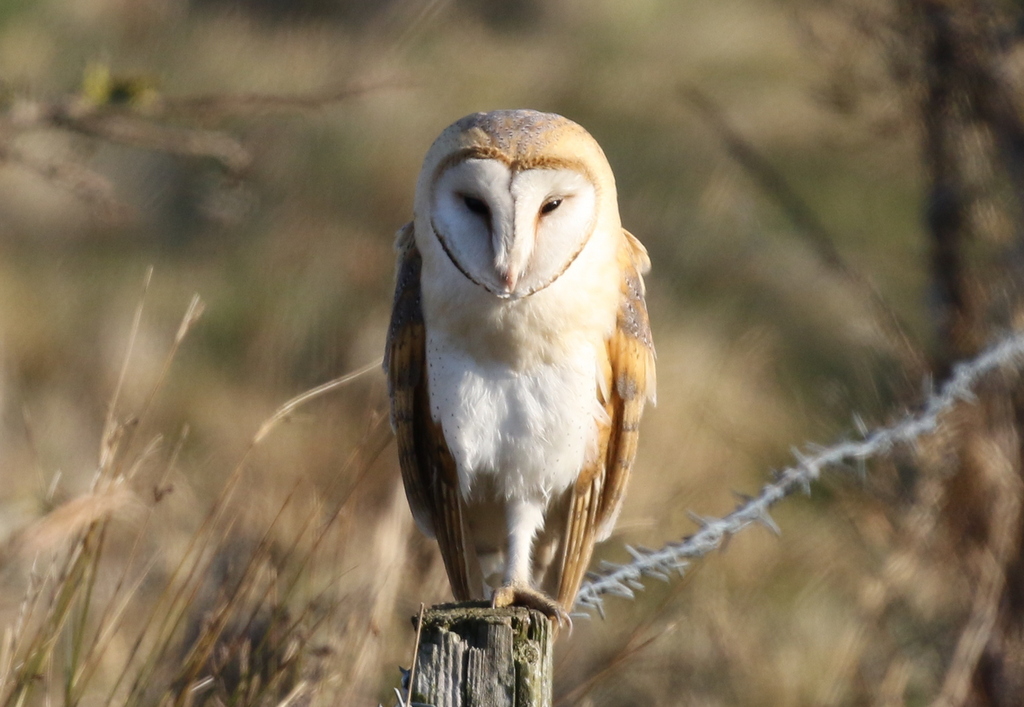
The Barn Owl stared at us for a while, seemingly unhappy at being rudely awoken from its slumbers, then flew back across the field and landed on another post on the other side.
Our first scheduled stop of the morning was at Titchwell. As we walked down the path towards the Visitor Centre, a Chiffchaff was singing from somewhere deep in the sallows. They have started singing early this year, lulled into thinking spring is here already with all the recent warm weather. We could hear our first Mediterranean Gulls of the day flying over too.
The feeders had been taken down for refilling, so there were no birds coming in, but there was lots of chattering from high in the trees around the Visitor Centre. We heard a redpoll singing and looked up to find a Lesser Redpoll perched in the very top of one of the trees. There were quite a few redpolls here this morning and several Siskins too. They were very mobile, flying around in the trees. When a little group of redpolls came down into the bushes lower down, we picked up one or two Mealy Redpolls too.
There have been small numbers of finches on the move in the last week or so, birds starting to head back north after spending the winter further south. We would hear small numbers of Siskin in particular moving through the day.
Stopping to scan the Thornham grazing meadow, a distant Common Buzzard was down in the grass in the middle and another was even further off on a bush at the back. Looking down into the ditch below the path, a Water Rail was picking around in the leaves in the bottom. We stopped to watch it, and a second Water Rail ran across the path a bit further up, which we could then see down in the water in the bottom as we walked on.

A couple of Cetti’s Warblers were calling from the edges of the reedbed, but despite one being very close to the path typically it kept well hidden. A male Reed Bunting was more obliging, perched in one of the small bushes. Through the scope we could see that its black head was still partly obscured by brown fringing which it still gradually wearing of.
Several Marsh Harriers were up beyond the bank at the back, over Brancaster marsh. Then another Marsh Harrier appeared closer to us, up from the reedbed. It was a male and as it flew across we could see it was carrying a couple of pieces of reed in its talons. It dropped down again into the reeds, presumably busy building up a nesting platform.
The old pool on Thornham grazing marsh is now getting overgrown and hard to see anything, but a quick look across as we passed revealed a Redshank down on the pool at the front and a smaller birds picking round the edge nearby. It was a Water Pipit. We had a good look at it through the scope, before it worked its way further back into the vegetation and disappeared.

The Water Pipit in recent days has mostly been seen feeding on the cut reed by the reedbed pool on the other side of the path, but they can be very difficult to see out here. There was one out here too, this morning. But it wasn’t until the first Water Pipit flew over from the Thornham side that we could see it. It flew across and chased off the new arrival, which returned across the path. What was possibly a third Water Pipit then flew up from the back and disappeared back over the reeds.
Several Common Snipe were also well hidden, roosting in the cut reeds. There were a few ducks out at the back of the reedbed pool – Common Pochard and Tufted Ducks. A Little Grebe was hiding behind the reeds on one of the small pools just below the path. A few Wigeon were feeding out on the saltmarsh behind us.
The Water Level on the Freshmarsh is still very high, although it has started to go down a touch and there was a little more mud exposed around the tallest of the islands. The Avocets were still roosting in the deeper water, with a good number now back here. On the small island by the junction with the path to Parrinder Hide, we could just see a small group of Knot busy bathing and preening on the mud at the back. A lone Golden Plover was standing with the Lapwings on the drier mud in the middle.
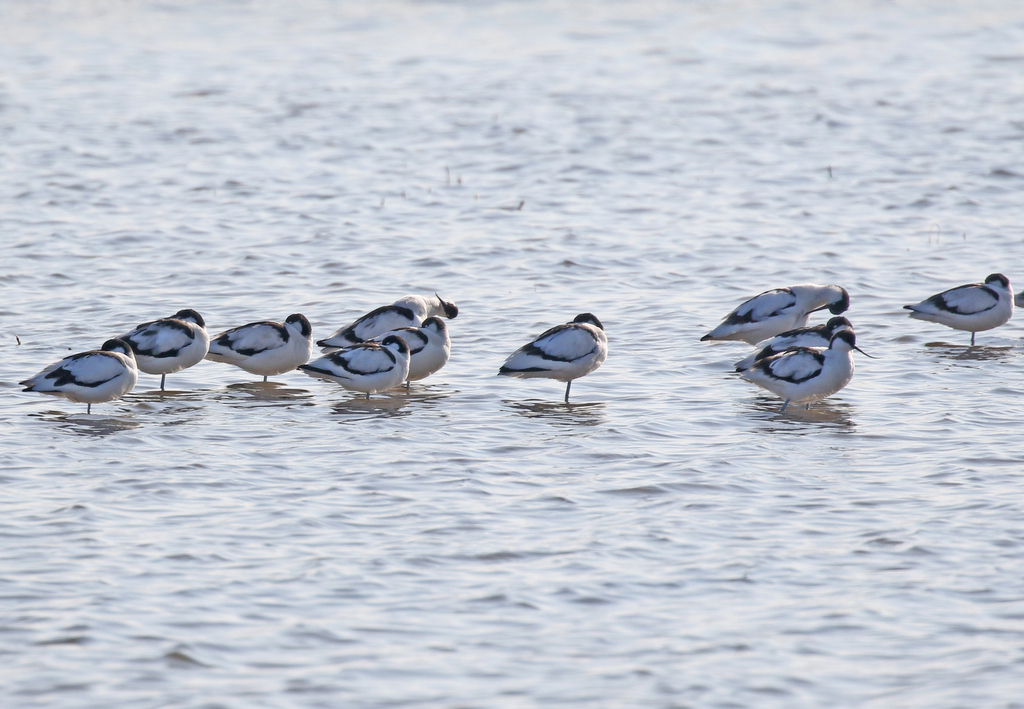
Some people returning from the beach told us there were a couple of Black-throated Divers offshore, so we decided to head straight out there. We had a quick look at the Volunteer Marsh on our way past. It looked pretty empty at first, apart from a few Redshanks, until a flock of Knot appeared from out of the vegetation and whirled round before flying back out towards the beach. There were more waders along the channel at the far end, more Redshanks, several Curlews, one or two Black-tailed Godwits and a little group of six Dunlin.
With the tide coming in, more waders were roosting on the non-tidal ‘Tidal Pools’. The water level has dropped here a little in the warm weather and there is a bit more space for them on here at the moment. There were several more little groups of Knot, with a few Bar-tailed Godwits and Grey Plover standing with them. A few diminutive Dunlin were running round the mud next to them.
By the time we got out to the beach, the Black-throated Divers had drifted east towards Scolt and further out. It was also very hazy offshore, but we managed to get one of the divers in the scope and get a good look at it – we could see the distinctive white flank patch. Several Great Crested Grebes and a single Razorbill were closer in, but everything else was rather distant. There were a few Red-breasted Mergansers and Goldeneye and three Eider flew past in the distance.
High tide was not until midday today, so we decided to make our way slowly back and head round to Holme to see if there was any more to see on the sea there. We called in at Parrinder Hide to admire the Mediterranean Gulls. Numbers are growing steadily now and it will be interesting to see how many pairs breed in 2019, after the big increase in pairs last year. We could see several pairs displaying in with the more numerous Black-headed Gulls on the fenced off Avocet Island, and we got a couple in the scope to look at the differences between the two species.
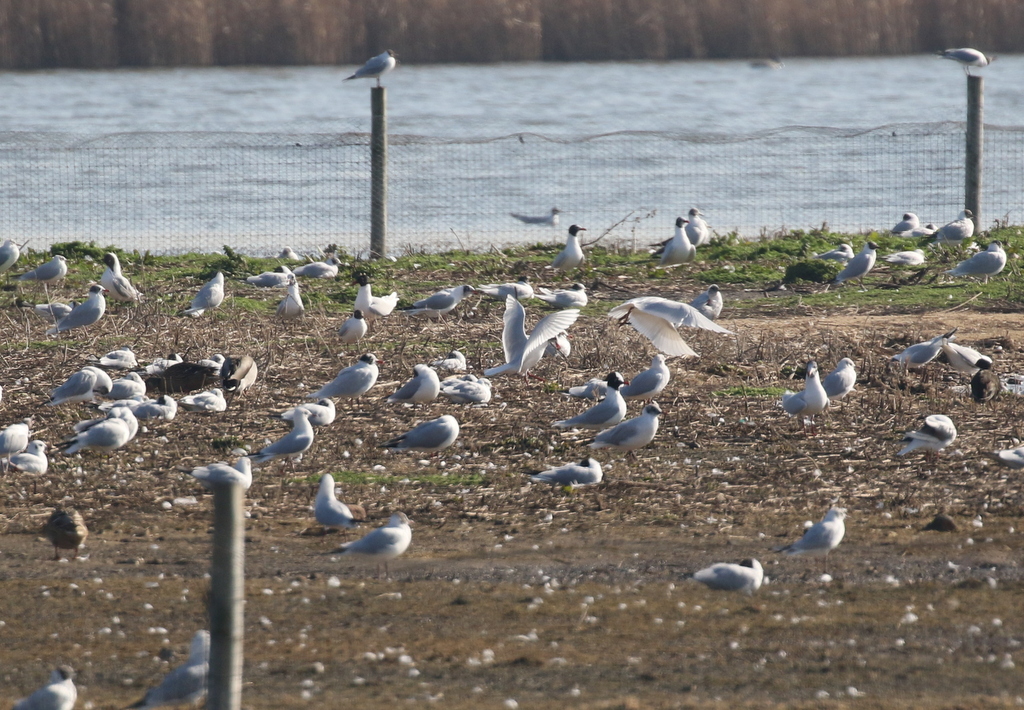
There were a few ducks still on the Freshmarsh. A good number of Teal were sleeping along the edge of the bank either side of the hide. Several pairs of Gadwall were roosting on the smaller islands along with a few Shoveler.
As we came out of the hide, we could hear a Marsh Harrier calling high above. We could just see it way up in the blue sky. It was flapping steadily and calling at first, but as it got back over towards the reedbed it started to tumble and twist, skydancing. A couple of Common Buzzards appeared in the sky too, circling over the path before drifting off west, possibly birds on the move.
We cut across by Meadow Trail, where there was no sign of the Woodcock now, round to Patsy’s Reedbed. There were not so many ducks on here today – just a few Gadwall, Common Pochard and Tufted Duck. Several Common Snipe were hiding in the cut reeds along the edge. Two or three Marsh Harrier circled up over the reedbed, and one drifted closer over the back of the pool.
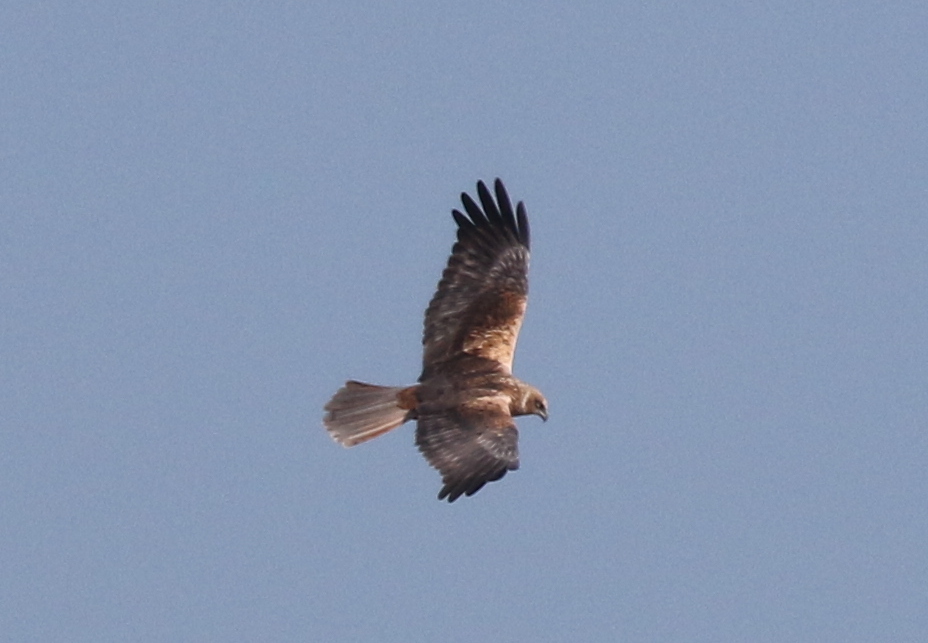
The highlight here though was the Bearded Tit. We could hear two birds pinging, one in the reeds in front of the right of the viewpoint and a second back on the edge of the reeds on the left of the pool. That second Bearded Tit worked its way closer along the edge of the pool and then perched up for a few seconds in full view – a smart male with powder blue-grey head black moustache. It zipped across the open water and disappeared into the reeds where the first bird had been calling, at which point both then went quiet.
Back to the Visitor Centre and after stopping to get a quick cup of tea, we headed round to Holme. It was lunchtime now, so we walked out to the beach with our food and scanned the sea while we ate. A Red Kite circled over the pines and drifted out over the beach, perhaps another raptor on the move taking advantage of the warm weather.
There were more birds on the sea off The Firs, but it was very hazy here too. The highlight was a Red-necked Grebe, which at one point swam up to join a small group of Great Crested Grebes, giving us a great comparison. There were lots more Red-breasted Mergansers off here and several more Eiders too. We still hadn’t found the Long-tailed Ducks, so once we had finished eating we decided to walk up through the dunes to Gore Point to try our luck there.
Another Marsh Harrier was calling from high over the grazing marshes, and we looked across to see several geese out on the grass. They were mostly Greylags but there were a small number of Pink-footed Geese still here too, smaller, darker-headed and darker-billed. Most of the winter’s Pink-footed Geese have already departed on their way back north, but a few are still lingering along the coast. The Brent Geese stay here a little longer and there was a tight flock out on the grazing marshes and several smaller groups flying in and out from the beach.

There were a lot more birds on the sea off Gore Point, and it didn’t take long to find the Long-tailed Ducks. They were diving regularly and hard to count, but eventually we got to a total of 21 together. The long tails of the drakes were hard to see when they were diving but when they stopped a couple of the drakes appeared to be displaying, swimming after a female with their tails cocked in the air.
There were even more Red-breasted Mergansers here – there seemed to be a very good number of them today, though they were too spread out to count easily. A distant Velvet Scoter appeared too briefly, but disappeared again when we took our eyes off it. A single Great Northern Diver was very distant, but a closer Slavonian Grebe then appeared. A Fulmar flew past low over the water. Non-avian interest included a Harbour Porpoise which rested at the surface for a few seconds before diving again.
Having walked up to Gore Point, we were a little later than planned leaving Holme which meant we could only enjoy a brief visit to Holkham on our way back east. There were lots of Wigeon still out on the grazing marshes by Lady Anne’s Drive as we parked, but not so many geese here now.
Out through the pines, we walked east on the edge of the saltmarsh. As we got closer to the cordon, we could see lots of pipits out in vegetation. A closer look revealed they were a mixture of Scandinavian Rock Pipits and Meadow Pipits. It was interesting to compare the two side by side, and also to compare and contrast the Rock Pipits with the closely related Water Pipit which we had seen earlier. There were a few Skylarks here too and one or two were singing in the sunshine.
There were a few people watching the Shorelarks already. They were quite a long way back in the taller vegetation before the cordon again, and a couple of people couldn’t resist the temptation to walk out onto the saltmarsh to get closer. We stood on the path and admired them through the scope. It was lovely afternoon light now and their bright yellow faces glowed in the sunshine when they lifted their heads.

The best strategy with the Shorelarks is to wait and let them come to you, and we could see they were gradually working their way towards the path further along. We walked up and watched them, busily picking around and creeping through the vegetation. We carried on a little further to see if the Dartford Warbler was still around, despite the fact it has not been reported here for a week or two. There was no sign of it and no sign of the Stonechat which has previously helped to tempt it out of the dense buckthorn, so we didn’t linger here.
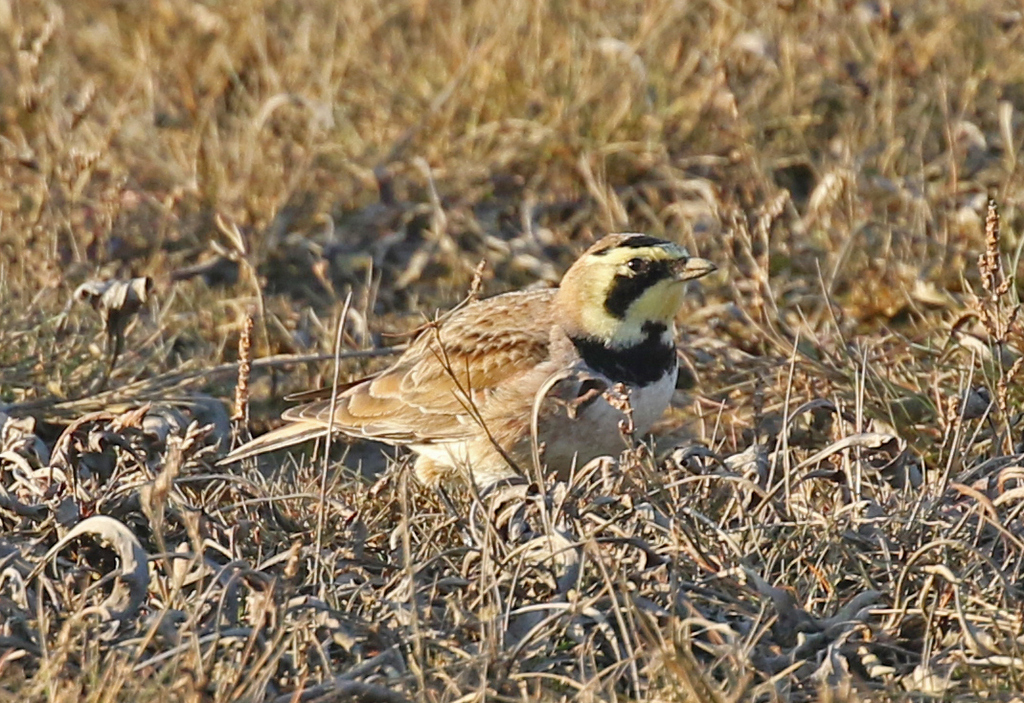
When we returned to the Shorelarks, they were very close to the path now and walking very slowly we were able to position ourselves without disturbing them. It was a great view of them from here. We tried to count them – there were at least 10 in the closer group, but there were still some further back on the saltmarsh which were mostly hidden. We still had one last thing we wanted to try to do today, so we eventually had to tear ourselves away
Continuing on along the coast, we parked and made our way down a track towards the saltmarsh. A male Marsh Harrier was still out hunting and crossed the track ahead of us. A few Chaffinches and tits flew in and out of the hedges ahead of us. We could hear a couple of Yellowhammers singing and had nice views of one of the males perched in the top of the hedge, bright yellow in the evening sun.

As we got down to the edge of the saltmarsh, a Barn Owl flew past across the grass in front of us. A nice start! A Peregrine was perched out on one of the sandbanks in the distance, but it was a long way off and little more than a blob in the misty haze even through the scope. A Marsh Harrier was quartering the back of the saltmarsh and a couple of late Common Buzzards circled over the edge of the field behind us calling.
Then a Hen Harrier appeared, a ringtail, flying in across the back of the saltmarsh. It was a long way off, but through the scope we could see the white square at the base of its tail. Shortly after, a second ringtail flew in a bit closer. It landed down in the vegetation for a few minutes and when it flew up again it came across and flushed the first Hen Harrier from where it was hiding. We saw the two of them several times over the next 15 minutes or so.
We really wanted to see a Merlin here, but they were a bit elusive this evening. Eventually the one other person down here with us spotted one, right at the back of the saltmarsh, perched on the top of a small bush. It was a long way off, but we could see what it was through the scope.
That was a great way to end, so with the light starting to go now we walked back up the track. There were loads of Brown Hares out in the fields here now. We stopped to listen to a couple of Grey Partridge calling from the next field over, which were then accompanied by a Red-legged Partridge calling too. Then it was time to head for home.
















